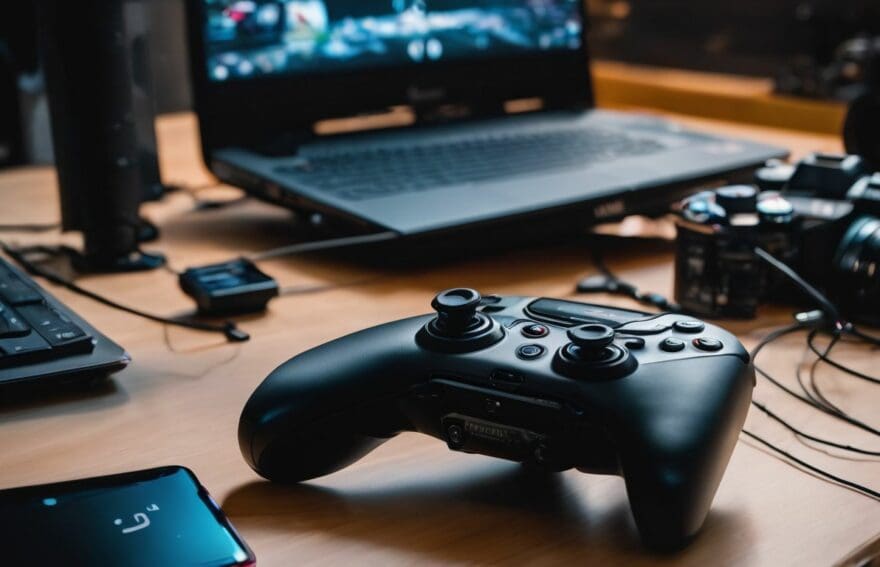The Future of Haptic Feedback in Competitive Gaming

Updated On: November 13, 2025 by 
Have you ever felt like your gaming experience could be more engaging, as if the action on the screen isn’t quite syncing with what’s in your hands? We know this frustration all too well and, armed with one intriguing fact – that haptic feedback is revolutionising how we play competitive games – we’ve delved deep into possibilities that await us.
Our findings shed light on how future technologies will not only make our games feel more real but also give us a sharper edge over our rivals. Don’t just play the game; feel it!
Evolution of Haptic Technology
From rumbling controllers to haptic feedback in eSports, the evolution of haptic technology has revolutionised competitive gaming. VR has also brought a new level of virtuosity to the gaming experience.
Rumbling Controllers
We’ve all felt the buzz of a controller in our hands as we navigate an intense moment in gaming. These rumbling controllers are more than just a fun addition; they provide tactile feedback that can lead to real advantages during play.
Every vibration is meticulously designed to guide your instincts, allowing you to respond faster and with greater precision.
Years ago, this technology might have been limited to simple vibrations, but today’s haptic feedback creates textured sensations that truly mimic the action on screen. Imagine feeling the grit of a racetrack or the recoil of a gun through these sophisticated triggers.
Not only does this enhance immersion, but it also gives us tangible clues about our virtual environments.
Our adrenaline spikes in sync with each pulse from advancements in gaming technology. The next step? We look forward to how haptic feedback will transform within eSports arenas where every second and sensation counts towards victory.
Haptic Feedback in eSports
Haptic feedback in eSports enhances the gaming experience for players, providing a heightened level of immersion and realism. With haptic technology, gamers can feel the impact of their actions within the game through sensations like vibrations and tactile feedback.
This not only adds an extra layer of sensory immersion but also improves gameplay by allowing players to physically sense in-game events such as collisions or environmental changes.
Additionally, haptic feedback offers competitive gamers a significant advantage by providing precise physical cues for better control and responsiveness.
Moving forward with advancements in haptic technology, eSports enthusiasts can look forward to even more realistic feedback that further blurs the lines between virtual and physical experiences.
The integration of haptics into eSports promises to revolutionise competitive gaming by elevating the interactive and immersive qualities of gameplay while offering tangible advantages for players.
The Virtuosity of VR
Virtual reality (VR) has redefined the gaming experience, introducing a new level of immersion through sensory feedback and realistic sensations. With haptic technology, players are able to feel the impact of their actions within the virtual environment, enhancing their gaming encounters with touch feedback and adaptive controllers.
This innovation not only elevates gameplay but also fosters a deeper connection between players and the virtual world, making it an essential component of modern interactive gaming experiences.
Furthermore, VR’s virtuosity lies in its potential to transport gamers into lifelike scenarios where they can interact with digital environments in ways previously unimaginable. As advancements continue to push boundaries, the future of VR promises even greater levels of realism and interactivity.
The evolving landscape of immersive technology is set to revolutionise competitive gaming by offering players unprecedented experiences that blur the lines between real life and virtual worlds.
Enhancing Realism in Competitive Gaming
Enhancing realism in competitive gaming is crucial for creating a more immersive experience. With haptic feedback, players can feel the impact of in-game actions, leading to improved gameplay and increased physical involvement.
Greater Immersion
Haptic feedback technology is advancing rapidly, enhancing the gaming experience through greater immersion. With haptic feedback, players can feel a heightened sense of realism as they interact with virtual environments and objects within games.
This not only creates a more engaging and thrilling experience but also adds an extra layer of depth to gameplay, making every action feel more impactful. As haptic technology continues to evolve, it promises to bring gamers into the heart of the action, allowing them to truly immerse themselves in virtual worlds and experiences.
Furthermore, haptic feedback provides a tactile dimension to gaming that goes beyond what traditional audio and visual cues offer. It allows players to physically sense the environment around them, adding an entirely new level of engagement that contributes to the overall enjoyment and excitement of competitive gaming.
Improved Gameplay
Enhanced haptic feedback has the potential to revolutionise gameplay, giving players a heightened sense of control and engagement. By providing tactile cues for in-game actions, such as the recoil of a weapon or the impact of a collision, haptic technology enriches the gaming experience with realistic physical sensations.
This not only deepens immersion but also allows players to feel more connected to their virtual surroundings. With improved haptic feedback, gamers can expect more precise and responsive interactions, leading to enhanced performance and an overall more satisfying gaming experience.
Furthermore, haptic feedback contributes to increased physical involvement in gameplay. It enables players to perceive environmental details through touch, making virtual worlds feel more tangible and believable.
Increased Physical Involvement
To enhance physical involvement in competitive gaming, haptic feedback technology is being integrated into gaming peripherals. This means that players can feel tactile sensations corresponding to in-game actions, such as the recoil of a weapon or the impact of a collision.
These realistic physical responses not only add an extra layer of immersion but also provide valuable sensory information, allowing gamers to react more instinctively and precisely.
Furthermore, advancements like adaptive triggers on controllers offer varying resistance depending on the in-game action, adding another dimension to physical engagement. As haptic technology continues to evolve, we can expect even greater physical involvement through more nuanced feedback and enhanced realism.
Future Applications for Haptic Feedback in Gaming
Imagine a gaming experience where you can feel the impact of every action, interact physically with virtual environments, and communicate through touch. This is just the beginning of what haptic technology has in store for competitive gaming.
Read on to discover more about its exciting future applications!
Full-Body Feedback
Haptic technology’s progression towards full-body feedback offers a transformative potential for competitive gaming. By extending haptic sensations beyond the hands, players can experience more comprehensive and immersive gameplay.
This cutting-edge innovation promises to simulate physical impacts and environmental elements throughout the entire body, elevating the level of realism and engagement in virtual worlds.
As a result, passionate gamers can anticipate an even deeper connection with their gaming experiences, while novice players will find themselves drawn into games like never before.
The advent of full-body feedback in competitive gaming is set to revolutionise how players interact with virtual environments. With enhanced tactile sensations spread across their bodies, gamers can expect heightened immersion and sensory involvement during gameplay.
Social Interaction
Advancements in haptic technology have paved the way for a more socially interactive gaming experience. Players can now feel the tactile sensations of their virtual environment, including the impact of their interaction with other players.
This heightened level of realism not only enhances the gaming experience but also fosters better communication and collaboration among gamers, promoting a sense of community within competitive gaming circles.
Moreover, haptic feedback can facilitate non-verbal communication between players, adding another layer of depth to social interactions in games. From conveying emotions to coordinating strategies, haptic technology provides a novel means for players to connect on a deeper level during gameplay.
Accessibility & Inclusivity
Haptic technology has the potential to make gaming more accessible and inclusive for all players. With modern haptics, gamers can rely on tactile feedback to enhance their gaming experience, providing a new dimension of accessibility that goes beyond traditional visual and auditory cues.
For instance, haptic feedback can be used as an accessibility tool to convey in-game audio information through vibrations, ensuring that players with hearing impairments are not left behind in competitive gaming environments.
Additionally, advancements in haptic technology have the capacity to create more inclusive gameplay experiences for a wider range of individuals by offering customisable settings to accommodate diverse physical abilities and preferences.
The future applications of haptic feedback extend beyond simply enhancing immersion – they have the potential to revolutionise inclusivity within the gaming community. As haptic technology continues to advance, it is expected that developers will integrate these features into games with the aim of creating a more inclusive environment for all gamers.
Advancements in Haptic Technology
The advancements in haptic technology have opened up new possibilities for a more immersive gaming experience. With next-gen consoles, programmable haptic feedback, and VR integration, the future of competitive gaming is set to be even more exhilarating.
Next-Gen Consoles
Next-gen consoles are revolutionising the gaming experience with cutting-edge technology, including advanced haptic feedback. These consoles are designed to provide more immersive and interactive gameplay, elevating the overall gaming experience for players.
With improved precision and realistic tactile sensations, next-gen consoles offer an enhanced sense of control that allows gamers to feel fully immersed in their virtual worlds.
The development of next-gen consoles also brings forth innovative advancements in haptic technology, enabling gamers to enjoy a heightened level of realism and interaction. By leveraging programmable haptic feedback and VR integration, these consoles open up new possibilities for creating truly immersive gaming environments.
Programmable Haptic Feedback
Gamers can look forward to programmable haptic feedback revolutionising their gaming experience. With this technology, players will have the ability to customise and fine-tune the sensory feedback they receive during gameplay.
By programming specific vibrations and tactile sensations, gamers can expect a more immersive and personalised experience that enhances their connection to the virtual world.
The introduction of programmable haptic feedback is set to provide an added layer of depth and realism to gaming experiences. By allowing players to adjust the intensity, duration, and patterns of haptic responses, developers can create tailored tactile cues for different in-game actions or events.
VR Integration
As we look into the future of haptic technology in gaming, one exciting prospect is its integration with virtual reality (VR). With VR becoming more accessible and prevalent in the gaming industry, the potential for enhanced immersion and realistic experiences is immense.
Through VR integration, haptic feedback can bring a new level of physical involvement to gaming, allowing players to feel a deeper connection with their virtual environment. This advancement holds promise not only for passionate gamers seeking a more immersive experience but also for novice gamers looking to step into the world of virtual reality.
Furthermore, VR integration will contribute to an enhanced gaming experience by providing players with a heightened sense of realism and interactivity. As haptic technology continues to evolve alongside advancements in virtual reality, we anticipate that the fusion of these innovations will revolutionise competitive gaming, offering players unprecedented levels of engagement and sensory feedback.
Conclusion
The future of competitive gaming will be shaped by the evolution and integration of haptic feedback technology. Gamers can anticipate greater immersion, improved gameplay, and increased physical involvement as haptic feedback becomes more sophisticated.
The advancements in haptic technology are set to revolutionise the gaming experience, making it more realistic, immersive, and interactive than ever before. With a wide range of applications and advancements on the horizon, the future of haptic feedback in competitive gaming is bright.
We can look forward to a transformed gaming industry with advanced haptic feedback enhancing players’ experiences across various platforms.
FAQs
1. What is haptic feedback in competitive gaming?
Haptic feedback in competitive gaming is a technology that simulates the sense of touch, allowing players to feel vibrations or movements in response to actions within the game.
2. How will haptic feedback change the future of gaming?
The future of haptic feedback promises more immersive experiences for gamers as it adds realistic physical sensations to gameplay which can enhance performance and enjoyment.
3. Can haptic feedback give gamers an advantage in competitions?
Yes, precise and responsive haptic feedback can provide competitive gamers with valuable cues about their environment or actions, potentially giving them an edge over opponents.
4. Is haptic feedback being used in current gaming innovations?
Indeed, many new games and gaming controllers are incorporating advanced haptic technologies that allow for more nuanced and diversified tactile responses during play.


